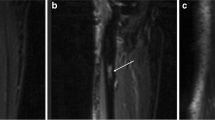Abstract
Purpose
The purpose of this study was to describe the prevalence and imaging appearance of radiation induced pseudotumors in patients following radiation therapy for extremity soft tissue sarcomas.
Materials and methods
We retrospectively reviewed the serial magnetic resonance (MR) images of 24 patients following radiation therapy for extremity soft tissue sarcomas. A total of 208 exams were reviewed (mean, 8.7 exams per patient) and included all available studies following the start of radiation therapy. Exams were analyzed for the identification of focal signal abnormalities within the surgical bed suggesting local tumor recurrence. Histopathologic correlation was available in nine patients suspected of having local tumor recurrence. Additional information recorded included patient demographics, tumor type and location, radiation type, and dose.
Results
The study group consisted of 12 men and 12 women, having an average age of 63 years (range, 39–88 years). Primary tumors were malignant fibrous histiocytoma (n = 13), leiomyosarcoma (n = 6), liposarcoma (n = 3), synovial sarcoma (n = 1), and extraskeletal chondrosarcoma (n = 1). All lesions were high-grade sarcomas, except for two myxoid liposarcomas. Average patient radiation dose was 5,658 cGy (range, 4,500–8,040 cGy). Average follow-up time was 63 months (range, 3–204 months). Focal signal abnormalities suggesting local recurrence were seen in nine (38%) patients. Three of the nine patients with these signal abnormalities were surgically proven to have radiation-induced pseudotumor. The pseudotumors developed between 11 and 61 months following the initiation of radiation therapy (mean, 38 months), with an average radiation dose of 5,527 cGy (range, 5,040–6,500 cGy). MR imaging demonstrated a relatively ill-defined ovoid focus of abnormal signal and intense heterogeneous enhancement with little or no associated mass effect.
Conclusion
MR imaging of radiation-induced pseudotumor typically demonstrates a relatively ill-defined ovoid mass-like focus of intense heterogeneous enhancement with little or no associated mass effect. Imaging follow-up or biopsy may be an alternative course of action to surgical re-exploration if this diagnosis is considered. The study revealed radiation-induced pseudotumor in 12.5% of patients in our extremity study group, suggesting that radiation-induced pseudotumor may be more prevalent than previously reported.




Similar content being viewed by others
References
Kransdorf MJ, Murphey MD. Imaging of soft tissue tumors. Philadelphia, PA: Lippincott, Williams & Wilkins; 2006. p. 38–79.
Vanel D, Shapeero LG, Tardivon A, Western A, Guinebretiere JM. Dynamic contrast-enhanced MRI with subtraction of aggressive soft tissue tumors after resection. Skeletal Radiol 1998;27(9): 505–510.
Vanel D, Shapeero LG, De Baere T, Gilles R, Tardivon A, Genin J, et al. MR imaging in the follow-up of malignant and aggressive soft-tissue tumors: results of 511 examinations. Radiology 1994;190(1): 263–268.
Glazer HS, Lee JK, Levitt RG, Heiken JP, Ling D, Totty WG, et al. Radiation fibrosis: differentiation from recurrent tumor by MR imaging. Radiology 1985;156(3): 721–726.
Ebner F, Kressel HY, Mintz MC, Carlson JA, Cohen EK, Schiebler M, et al. Tumor recurrence versus fibrosis in the female pelvis: differentiation with MR imaging at 1.5 T. Radiology 1988;166(2): 333–340.
Daldrup-Link HE, Henning T, Link TM. MR imaging of therapy-induced changes of bone marrow. Eur Radiol 2007;17(3): 743–761.
Budach V, Stuschke M, Budach W, Molls M, Sack H. Radiation response in 10 high-grade human soft tissue sarcoma xenografts to photons and fast neutrons. Int J Radiat Oncol Biol Phys 1990;19(4): 941–943.
Laramore GE, Griffith JT, Boespflug M, Pelton JG, Griffin T, Griffin BR, et al. Fast neutron radiotherapy for sarcomas of soft tissue, bone, and cartilage. Am J Clin Oncol 1989;12(4): 320–326.
Panicek DM, Schwartz LH, Heelan TT, Caravelli JF. Non-neoplastic causes of high signal intensity at T2-weighted MR imaging after treatment for musculoskeletal neoplasm. Skeletal Radiol 1995;24(3): 185–190.
Hwang S, Lefkowitz R, Landa J, et al. Local changes in bone marrow at MRI after treatment of extremity soft tissue sarcoma. Skeletal Radiol 2009;38(1): 11–19.
Vanel D, Lacombe MJ, Couanet D, Kalifa C, Spielmann M, Genin J. Musculoskeletal tumors: follow-up with MR imaging after treatment with surgery and radiation therapy. Radiology. 1987;164(1): 243–245.
Author information
Authors and Affiliations
Corresponding author
Rights and permissions
About this article
Cite this article
Moore, L.F., Kransdorf, M.J., Buskirk, S.J. et al. Radiation-induced pseudotumor following therapy for soft tissue sarcoma. Skeletal Radiol 38, 579–584 (2009). https://doi.org/10.1007/s00256-009-0653-6
Received:
Revised:
Accepted:
Published:
Issue Date:
DOI: https://doi.org/10.1007/s00256-009-0653-6




